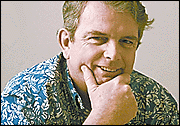


The Way I See It
I hope I won't feel too old in the next century to get up at 2 a.m. and climb into the bed of a pickup truck in a driving rain to cover the Honolulu Marathon. Covering marathon is
a unique experienceIt has been an Indiana Jones adventure every one of the last 14 years I've covered the race.
I think I need it once a year to keep at least my blood running. And I'd recommend it.
There's no substitute for a birds-eye view of the athletic phenomenon of distance dueling.
I love watching these human running machines adjust speeds, plot, maneuver and overcome nausea in the late stages of the 26.2-mile ordeal, maintaining paces just over 5 minutes per mile.
They do it on one of the world's most difficult courses and under some of the most adverse climate conditions for distance runners.
And then what do they do? Hell, they sprint to the finish like they were on a track.
If Riley Wallace could recruit and teach Kenyans Jimmy Muindi, Mbarak Hussein, Erick Kimaiyo, Fred Kiprop and Douglas Wahihuri to shoot off the dribble and play man-to-man defense, he'd win every nonconference and WAC game on sheer conditioning.
(Have to be. Marathoners aren't very tall.)
I don't mind the soreness of my backside, the cramps that develop in my legs and the weather-beating that I and the Star-Bulletin photographer absorb as we ride in the open vehicle.
Photogs battling the elements and sleep deprivation the past several years have been Kathryn Bender (who nailed the famous temper flare-up between the women's leaders in the 1997 race), George Lee and, this year, Dennis Oda.
Oda, loaded down with equipment, paid a painful price on Sunday for getting up-close-and-personal shots in the chute when he took a nasty spill on the rain-slicked pavement. But he bounced back tough and continued to shoot.
Frank Shorter, the only American to win Olympic marathon gold in the last 91 years, is 52 and he didn't seem to mind the elements or the 5 a.m. start in darkness.
Pelted by rain, and clad only in running shorts and a quilted vest, Shorter perilously perched himself on the shallow wall of the pace truck while holding a wind-screened microphone to do the KGU marathon broadcast.
One writer looked up at the 20th century sports icon and asked in a concerned voice, "Are you OK up there, Frank?"
Preoccupied, Shorter muttered, "I'm fine, I'm fine."
IT'S compelling to note that for the last Honolulu Marathon of the 1900s, KGU had three symbols of America's bygone marathon glory covering the race on Sunday.
Besides Shorter, there was Alberto Salazar, the last American to hold a world record in the marathon, doing commentary at the finish. And there was Greg Meyer, the last American (1983) to win the Boston Marathon, broadcasting from the women's pace truck.
By the way, Honolulu's 21,141 official finishers on Sunday make it the fifth-largest marathon in the world this year. Ahead are London (which had a staggering 38,809 finishers), New York (America's largest with 31,785 finishers), Chicago and then Berlin.
Pat Bigold has covered sports for daily newspapers
in Hawaii and Massachusetts since 1978.